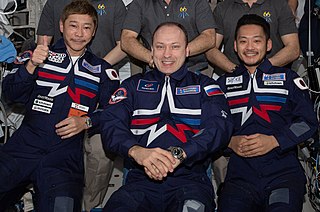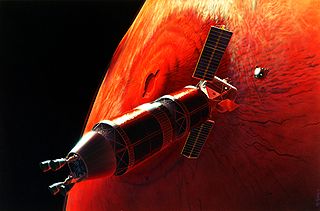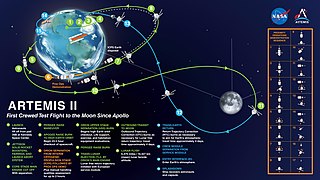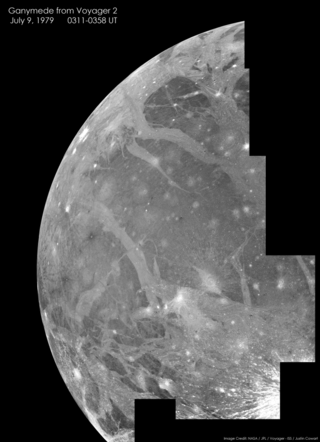
Human spaceflight is spaceflight with a crew or passengers aboard a spacecraft, often with the spacecraft being operated directly by the onboard human crew. Spacecraft can also be remotely operated from ground stations on Earth, or autonomously, without any direct human involvement. People trained for spaceflight are called astronauts, cosmonauts (Russian), or taikonauts (Chinese); and non-professionals are referred to as spaceflight participants or spacefarers.

Space exploration is the use of astronomy and space technology to explore outer space. While the exploration of space is currently carried out mainly by astronomers with telescopes, its physical exploration is conducted both by uncrewed robotic space probes and human spaceflight. Space exploration, like its classical form astronomy, is one of the main sources for space science.

Space tourism is human space travel for recreational purposes. There are several different types of space tourism, including orbital, suborbital and lunar space tourism.
Human spaceflight programs have been conducted, started, or planned by multiple countries and companies. The age of manned rocket flight was initiated by Fritz von Opel who piloted the world's first rocket-propelled flight on 30 September 1929. All space flights depend on rocket technology; von Opel was the co-designer and financier of the visionary project. Until the 21st century, human spaceflight programs were sponsored exclusively by governments, through either the military or civilian space agencies. With the launch of the privately funded SpaceShipOne in 2004, a new category of human spaceflight programs – commercial human spaceflight – arrived. By the end of 2022, three countries and one private company (SpaceX) had successfully launched humans to Earth orbit, and two private companies had launched humans on a suborbital trajectory.

Dennis Anthony Tito is an American engineer and entrepreneur. In mid-2001, he became the first space tourist to fund his own trip into space, when he spent nearly eight days in orbit as a crew member of ISS EP-1, a visiting mission to the International Space Station. This mission was launched by the spacecraft Soyuz TM-32, and was landed by Soyuz TM-31.

Private spaceflight refers to spaceflight developments that are not conducted by a government agency, such as NASA or ESA.

TMK was the designation of a Soviet space exploration project to send a crewed flight to Mars and Venus without landing.

Manned Venus Flyby was a 1967–1968 NASA proposal to send three astronauts on a flyby mission to Venus in an Apollo-derived spacecraft in 1973–1974, using a gravity assist to shorten the return journey to Earth.

Jane Poynter is an American aerospace executive, author and speaker. She is founder, co-CEO and CXO of Space Perspective, a luxury space travel company. She was co-founder and former CEO of World View Enterprises, a private near-space exploration and technology company headquartered in Tucson, Arizona. Poynter was also a founding member of the Biosphere 2 design team and a crew member from the original two-year mission inside the materially closed ecological system.

The idea of sending humans to Mars has been the subject of aerospace engineering and scientific studies since the late 1940s as part of the broader exploration of Mars. Long-term proposals have included sending settlers and terraforming the planet. Proposals for human missions to Mars have come from agencies such as NASA, CNSA, the European Space Agency, Boeing, and SpaceX. As of 2023, only robotic landers and rovers have been on Mars. The farthest humans have been beyond Earth is the Moon, under the Apollo program.

The National Aeronautics and Space Administration is an independent agency of the U.S. federal government responsible for the civil space program, aeronautics research, and space research. Established in 1958, NASA succeeded the National Advisory Committee for Aeronautics (NACA) to give the U.S. space development effort a distinctly civilian orientation, emphasizing peaceful applications in space science. NASA has since led most American space exploration, including Project Mercury, Project Gemini, the 1968–1972 Apollo Moon landing missions, the Skylab space station, and the Space Shuttle. NASA currently supports the International Space Station and oversees the development of the Orion spacecraft and the Space Launch System for the crewed lunar Artemis program, the Commercial Crew spacecraft, and the planned Lunar Gateway space station.

Mars orbit rendezvous (MOR) is a space travel concept where two spacecraft meet up and/or dock in Mars orbit.

A Mars flyby is a movement of spacecraft passing in the vicinity of the planet Mars, but not entering orbit or landing on it. Uncrewed space probes have used this method to collect data on Mars, as opposed to orbiting or landing. A spacecraft designed for a flyby is also known as a "flyby bus" or "flyby spacecraft".

Artemis 2 is the second scheduled mission of NASA's Artemis program and the first scheduled crewed mission of NASA's Orion spacecraft, currently planned to be launched by the Space Launch System (SLS) no earlier than November 2024. Four astronauts are to perform a flyby of the Moon and return to Earth, being the first crewed mission beyond low Earth orbit since Apollo 17 in 1972. The mission is also planned to be the first crewed launch from Launch Complex 39B of the Kennedy Space Center since STS-116 in 2006.

The Mars Excursion Module (MEM) was a spacecraft proposed by NASA in the 1960s for use in a human mission to Mars, and this can refer to any number of studies by corporations and spaceflight centers for Mars landers. However, primarily a MEM referred to a combination of a Manned Mars lander, short-stay surface habitat, and Mars ascent stage. Variations on a MEM included spacecraft designs like an uncrewed Mars surface cargo delivery, and there was a MEM lander that combined a communications center, living habitat, and laboratory.

A flyby is a spaceflight operation in which a spacecraft passes in proximity to another body, usually a target of its space exploration mission and/or a source of a gravity assist to impel it towards another target. Spacecraft which are specifically designed for this purpose are known as flyby spacecraft, although the term has also been used in regard to asteroid flybys of Earth for example. Important parameters are the time and distance of closest approach.

The Deep Space Transport (DST), also called Mars Transit Vehicle, is a crewed interplanetary spacecraft concept by NASA to support science exploration missions to Mars of up to 1,000 days. It would be composed of two elements: an Orion capsule and a propelled habitation module. As of late 2019, the DST is still a concept to be studied, and NASA has not officially proposed the project in an annual U.S. federal government budget cycle. The DST vehicle would depart and return from the Lunar Gateway to be serviced and reused for a new Mars mission.



























